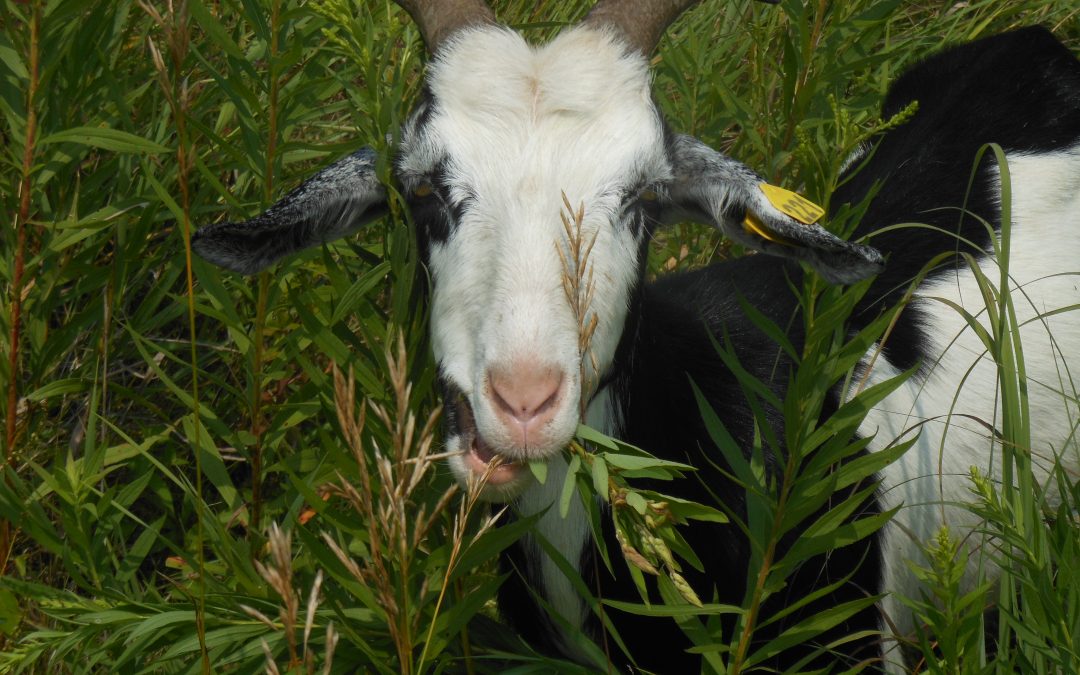By Caitlin Williamson, Natural Resources Foundation of Wisconsin
 The Riveredge Nature Center in Ozaukee County wanted to try a different approach to land management. A goat approach. Using a local company, Riveredge hired 32 hungry goats (and their herder) to remove dense undergrowth vegetation and eat invasive plants, such as autumn olive and buckthorn, on the nearly 400 acres of forest and prairies in southeastern Wisconsin.
The Riveredge Nature Center in Ozaukee County wanted to try a different approach to land management. A goat approach. Using a local company, Riveredge hired 32 hungry goats (and their herder) to remove dense undergrowth vegetation and eat invasive plants, such as autumn olive and buckthorn, on the nearly 400 acres of forest and prairies in southeastern Wisconsin.
The project was supported by a $1,000 grant from the Natural Resources Foundation of Wisconsin’s C.D. Besadny Conservation Grant Program, which provides small, matching grants to conservation organizations in support of projects that promote the responsible stewardship of Wisconsin’s natural resources at the local level.
Over the last 45 years, the Riveredge Sanctuary has been restored to a natural area showcasing many different native Wisconsin habitat types, including prairies, deciduous and coniferous forests, riparian areas, and wetland complexes. However, it takes a lot of work to manage these lands.
“Using grazing as a land management technique for invasive species was a completely new concept over here in southeastern Wisconsin,” said Amanda Zopp, senior naturalist for Riveredge Nature Center. “It was not in the realm of typical management concepts in this part of the state, so it was nice to be one of the first ones to break the barrier.”
Disturbance is an important process in maintaining healthy ecosystems. Both natural and man-made disturbances, such as fire and farming, created a mosaic of ecosystem types throughout southeastern Wisconsin. However, once the land was no longer being farmed, the lack of disturbances allowed brushy understory, successional woody vegetation, and invasive plant species to become densely established.
Which is where the goats come in.
Ben Robel, owner of Vegetation Solutions LLC, brought in a herd of 32 goats, and with great efficiency defoliated several species of invasive species, including autumn olive, common buckthorn, and burdock, as well as aggressive species including poison ivy and prickly ash, all within a few days. Ben stayed with the goats day and night while they munched away.
In addition to being efficient eaters, goats can get in hard-to-reach places, and can graze up to 6 or 7 feet while standing on their back legs. In total, Robel has approximately 100 goat and sheep ‘employees’, which he uses all over the state.
“Historically, fire and grazing animals created the landscapes, so it seems fitting that we’re using this natural method,” Robel said. “It’s just another resource in our toolbox for managing landscapes.”
In addition to preserving the sanctuary and other natural areas, Riveredge Nature Center sets an example for environmental decision-making and sustainable practices through education and outreach. The goat project has showcased a progressive land management style, and has influenced private landowners and other nature centers in the region by prompting them to consider this natural method.



